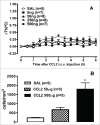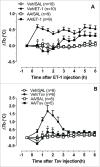Central mediators involved in the febrile response: effects of antipyretic drugs
- PMID: 27227071
- PMCID: PMC4843933
- DOI: 10.1080/23328940.2015.1102802
Central mediators involved in the febrile response: effects of antipyretic drugs
Abstract
Fever is a complex signal of inflammatory and infectious diseases. It is generally initiated when peripherally produced endogenous pyrogens reach areas that surround the hypothalamus. These peripheral endogenous pyrogens are cytokines that are produced by leukocytes and other cells, the most known of which are interleukin-1β, tumor necrosis factor-α, and interleukin-6. Because of the capacity of these molecules to induce their own synthesis and the synthesis of other cytokines, they can also be synthesized in the central nervous system. However, these pyrogens are not the final mediators of the febrile response. These cytokines can induce the synthesis of cyclooxygenase-2, which produces prostaglandins. These prostanoids alter hypothalamic temperature control, leading to an increase in heat production, the conservation of heat, and ultimately fever. The effect of antipyretics is based on blocking prostaglandin synthesis. In this review, we discuss recent data on the importance of prostaglandins in the febrile response, and we show that some endogenous mediators can still induce the febrile response even when known antipyretics reduce the levels of prostaglandins in the central nervous system. These studies suggest that centrally produced mediators other than prostaglandins participate in the genesis of fever. Among the most studied central mediators of fever are corticotropin-releasing factor, endothelins, chemokines, endogenous opioids, and substance P, which are discussed herein. Additionally, recent evidence suggests that these different pathways of fever induction may be activated during different pathological conditions.
Keywords: chemokine; corticotropin-releasing factor; endogenous opioids; endothelin; fever; prostaglandin; substance P.
Figures







Similar articles
-
Circulating cytokines as mediators of fever.Clin Infect Dis. 2000 Oct;31 Suppl 5:S178-84. doi: 10.1086/317513. Clin Infect Dis. 2000. PMID: 11113021 Review.
-
The neurobiology of the human febrile response.AANA J. 2006 Apr;74(2):145-50. AANA J. 2006. PMID: 16617919 Review.
-
Female Sex Hormones Influence the Febrile Response Induced by Lipopolysaccharide, Cytokines and Prostaglandins but not by Interleukin-1β in Rats.J Neuroendocrinol. 2016 Oct;28(10). doi: 10.1111/jne.12414. J Neuroendocrinol. 2016. PMID: 27483048
-
Endogenous pyrogens in the CNS: role in the febrile response.Prog Brain Res. 1992;93:419-28; discussion 428-9. doi: 10.1016/s0079-6123(08)64587-2. Prog Brain Res. 1992. PMID: 1480760 Review.
-
Evidence of substance P autocrine circuitry that involves TNF-α, IL-6, and PGE2 in endogenous pyrogen-induced fever.J Neuroimmunol. 2016 Apr 15;293:1-7. doi: 10.1016/j.jneuroim.2016.01.016. Epub 2016 Jan 27. J Neuroimmunol. 2016. PMID: 27049554
Cited by
-
Fever and Antipyretic Supported by Traditional Chinese Medicine: A Multi-Pathway Regulation.Front Pharmacol. 2021 Mar 22;12:583279. doi: 10.3389/fphar.2021.583279. eCollection 2021. Front Pharmacol. 2021. PMID: 33828481 Free PMC article. Review.
-
Brazil: What country is this?Temperature (Austin). 2016 Feb 25;3(1):11-4. doi: 10.1080/23328940.2016.1150698. eCollection 2016 Jan-Mar. Temperature (Austin). 2016. PMID: 27227087 Free PMC article. No abstract available.
-
Do Bacteremic patients with end-stage renal disease have a fever when presenting to the emergency department? A paired, retrospective cohort study.BMC Emerg Med. 2020 Jan 9;20(1):2. doi: 10.1186/s12873-019-0298-2. BMC Emerg Med. 2020. PMID: 31918657 Free PMC article.
-
The Neurokinin-1 Receptor Contributes to the Early Phase of Lipopolysaccharide-Induced Fever via Stimulation of Peripheral Cyclooxygenase-2 Protein Expression in Mice.Front Immunol. 2018 Feb 5;9:166. doi: 10.3389/fimmu.2018.00166. eCollection 2018. Front Immunol. 2018. PMID: 29459872 Free PMC article.
-
An Evaluation of the Anti-Inflammatory Effects of a Thai Traditional Polyherbal Recipe TPDM6315 in LPS-Induced RAW264.7 Macrophages and TNF-α-Induced 3T3-L1 Adipocytes.Curr Issues Mol Biol. 2023 Jun 5;45(6):4891-4907. doi: 10.3390/cimb45060311. Curr Issues Mol Biol. 2023. PMID: 37367060 Free PMC article.
References
-
- Roth J, De Souza GE. Fever induction pathways: evidence from responses to systemic or local cytokine formation. Braz J Med Biol Res 2001; 34:301-14; PMID:11262580; http://dx.doi.org/10.1590/S0100-879X2001000300003 - DOI - PubMed
-
- Dinarello CA, Cannon JG, Wolff SM. New concepts on the pathogenesis of fever. Rev Infect Dis 1988; 10:168-89; PMID:2451266; http://dx.doi.org/10.1093/clinids/10.1.168 - DOI - PubMed
-
- Boulant JA. Neuronal basis of Hammel's model for set-point thermoregulation. J Appl Physiol 2006; 100:1347-54; PMID:16540713; http://dx.doi.org/10.1152/japplphysiol.01064.2005 - DOI - PubMed
-
- Gay NJ, Gangloff M, Weber AN. Toll-like receptors as molecular switches. Nat Rev Immunol 2006; 6:693-8; PMID:16917510; http://dx.doi.org/10.1038/nri1916 - DOI - PubMed
Publication types
LinkOut - more resources
Full Text Sources
Other Literature Sources
Research Materials
